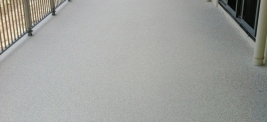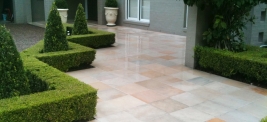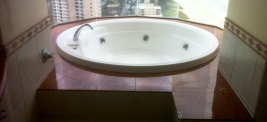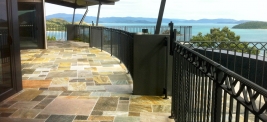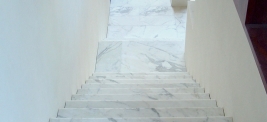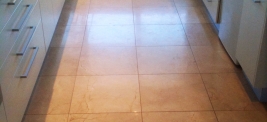Marble is an extremely soft stone. You may notice that your marble tile surface has lost its polished appearance and become dull and lifeless. It may look dirty but it actually may have become scratched, worn and dull over time and may need to be polished.
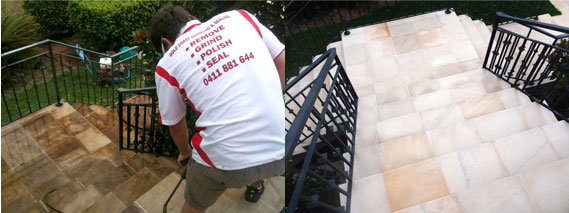
In many cases the marble tiles in floors and countertops will not look much different after they have been cleaned. Many people expect scratches, etch marks and discolorations in the marble tiles to be removed when the marble tiles have been cleaned. It is necessary to have a professional to polish the marble and remove these marble tile imperfections.
TRAVERTINE is a natural stone made from terrestrial deposits of limestone that were formed when cooling, carbonated groundwater was exposed to the air.
Travertine tiles therefore naturally have voids in them from the trapped air. Many travertine tiles are filled with an epoxy resin before they are installed. Some travertine is installed prior to filling the voids and these voids can make unfilled travertine tile difficult to clean. Travertine tiles are dense tiles and are generally resilient to most types of alkaline based cleaning products.
Cleaning a travertine shower takes special attention due to the soap scum buildup and the constant water source. If the grout lines are extremely damaged and dirty then it may be necessary to re-grout your travertine tile grout lines to restore your grout to like new condition. Many times travertine tiles require a professional tile polishing and restoration procedure to restore the travertine tile surface which we can help you with.
The dirt and stains on travertine tiles is of an acidic nature.
Therefore it is necessary we use an alkaline cleaning product to react with the acidic grime on the tiles to dissolve it and make it easier to clean.
Travertine tiles are dense but they will still absorb water and oil based contaminates so it is important to seal the travertine tiles after they have been polished. You do not want to have your beautiful newly polished travertine tiles to become stained after they have been polished. It is especially important to seal any travertine shower tiles after they have polished. You want to protect the natural travertine stone as much as possible from the damaging effects of hard water, soap scum, mold and mildew that can be present in a travertine tile shower installation.
Travertine tiles may need to be periodically honed or polished to maintain their finish. The regular cleaning, polishing, honing and maintenance requirements of travertine tile are what every homeowner must deal with when having travertine tiles installed.
Please refer to our dedicated Marble (travertine) page
Depending on the look you desire from your travertine there are various types of matte or glossy polishing options available. Polishing or honing travertine is a difficult task and should only be done by trained stone restoration professionals. Cleaning and restoring travertine tile can be a difficult and labor-intensive task.
Polishing a travertine tile installation is not a simple task. When travertine tiles were first installed there will always be some lippage between the adjacent tiles. Lippage is where adjacent tiles are higher or lower then the tiles adjacent to them. This lippage needs to be removed before any kind of travertine restoration procedure can begin. If the lippage is not removed from the travertine tile installation then when the travertine tiles are polished “picture framing” can occur. Picture framing is when the edges of the tiles get polished while the center of the tiles, do not get polished. Essentially a picture framing effect can take place on the travertine tiles and you can see why it is essential to remove the lippage on the travertine tiles before they can be polished.
When you get your travertine polished or honed it is extremely important to understand the desired results before you commit to having your travertine tiles polished. Some people like the look of travertine when it is highly polished while others want the natural beauty of the marble/travertine stone to show with a honing procedure. Therefore there will be various finish options available to you for having your travertine tiles polished.
- High polished finish. A High polished finish will give you the maximum polished look that will reflect light and images off of the travertine. This high polished look will give you a polished that many people desire but it will also take away some of the natural look of the tiles. This polished look is achieved when the tiles are polished up to the 1600 grit level and even sometimes up to higher grits for even more of a polished look. It is important to understand that travertine is not like granite in that it has its limits and limitations as to just how much of a polished look is possible with travertine. Also it is important to understand that when you polish the travertine tiles, the fill material will not be able to be polished as much as the travertine tiles themselves. Therefore the look you will achieve is one of highly polished tile and lesser polished fill areas.
- Low polished finish. Low polished travertine is done just like high polished travertine except that the finer grit diamond pads are not used and the travertine is typically only polished up to the 800 grit level. With low polished travertine tiles there will not be as much of a reflective polished look to the travertine but the fill areas will become less apparent and blend in more with the rest of the actual travertine tiles.
- High honed finish. A high honed travertine polishing procedure will give you a honed or matte look to the marble/travertine tile installation. With a high honed tile-polishing procedure the travertine is only polished up to the 400 grit level. This type of procedure will bring out much of the natural look of the travertine stone but still retain some level of reflection to the travertine tiles. Also with a high honed finish the travertine tiles and the fill material will blend in much more and become almost indistinguishable between the two.
- Low honed finish. A low honed travertine polishing procedure will essentially take out all the reflective properties of the travertine tile installation. The travertine tile will show its most natural state and the fill material will blend in with the travertine tiles. With this type of travertine polishing procedure only the 200 or 100 grit diamond pads are used to get this type of low honed finish effect.

